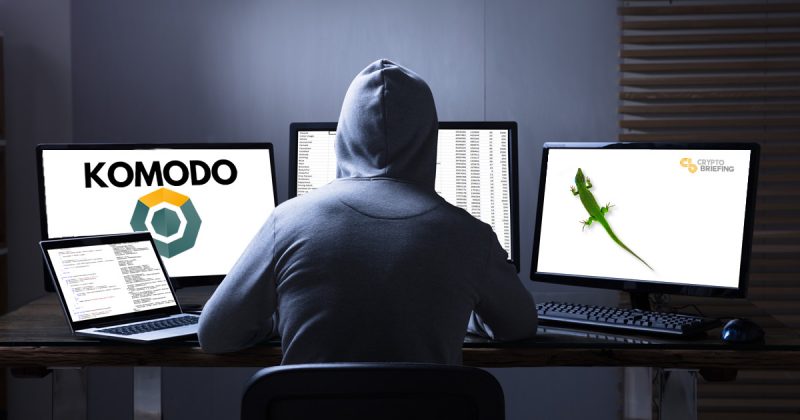What Is Komodo? Introduction To KMD Token

Share this article
What Is Komodo?
Komodo Platform is different things to different people. It’s a decentralized exchange supporting 95% of coins. It’s a crypto wallet. It’s a crowdfunding platform. And a privacy cryptocurrency. And a fuel for a language-agnostic smart contract technology. Komodo is, to say the least, versatile.
And it’s just about to rebrand, we learn, on the very same day we came up with this snappy graphic. (Yes, we know it’s not a Komodo Dragon – but it is a ‘monitor lizard’…)
We started the discussion of privacycoins with Zcash and its improvement in Bitcoin’s anonymity problem.
Komodo Platform uses the same protocol as Zcash, adding a delayed Proof-of-Work (d-PoW) consensus mechanism and SuperNET to the fork. SuperNET is a decentralized organization dedicated to creating open-source tools like a decentralized exchange called BarterDEX capable of atomic swaps and a cross-chain compatibility tool called Peerchains.
Essentially Zcash 2.0, the Komodo line-up of developers is (can you believe this) pseudonymous. Founder JL777 and his team believe in anonymity and privacy, a concept that’s both intriguing and scary for investors. This means it’s competing with privacy coins like Zcash, Monero, Dash, and Verge.
But it’s more than a privacy coin – it’s a security-focused blockchain development platform that’s compatible with quantum computing and other future technologies.
The Komodo crypto and blockchain tech have a lower profile than its competitors. It’s somewhat of a rebranding of the original Bitcoin Dark program. Is that a strength or weakness in today’s crypto market?
To find out, let’s start by analyzing the market performance of KMD, Komodo’s proprietary cryptocurrency coin.
Breakdown of KMD Token
Komodo a total supply of 200,000,000 KMD. Its peak price of $12.89 occurred on December 21, 2017, when the market cap was significantly higher.
The Komodo ICO from October 15 – November 20, 2016 raised 2639 BTC and distributed 90 million KMD to investors. Another 10 million was held by the Komodo team for future development and marketing purposes.
Mining Komodo KMD is achieved through a Proof-of-Stake (PoS) algorithm and delayed Proof-of-Work (d-PoS) consensus model. It’s thought by the general crypto community that d-PoW is more resistant to 51 percent attacks than traditional PoW networks.
At its core, d-PoW is designed to shorten the blockchain and improve processing speeds, while archiving older blocks in a way that makes them accessible if necessary into the future. It’s similar to the sharding concept used by coins like Zilliqa and IOST and what helps secure transaction privacy and user anonymity more than traditional coins like Bitcoin.
KMD is tradeable on Binance, Bittrex, Upbit, and HitBTC, although volume is quite low, averaging around $1,000,000 per day. Holding at least 10 KMD gains a 5.1 percent compound KMD reward, so it’s a nice coin to hodl. It’s difficult to buy with fiat, but by using BTC or ETH as a pass-through, it is simple enough to buy Komodo KMD.
There are quite a few Komodo wallets for all OS platforms and even paper. Although the Agama Wallet is the official crypto wallet, Ledger Wallet, MyEther Wallet, and a handful of others support KMD. So, you don’t need to go with the branded Agama Wallet.
The Shroud of Mystery
One of the more interesting aspects of the crypto market is how many scams are perpetrated by known people versus how many legitimate projects were launched by Anonymous.
Privacy is important to the Komodo team, but that doesn’t mean it’s not capable of creating some serious blockchain tech. The Komodo Platform has real potential.
In fact, the Komodo blockchain roadmap is much more like Ethereum’s than its privacy coin brethren. It includes plans for an ICO platform, dApp development, mobile wallets, and a fresh new user interface. The atomic swap technology could be one of its major selling points.
Once developed, its BarterDEX will allow atomic swaps right out of your private wallet. It’ll also allow multiple orders for different coins, a light database, and decentralized ordering to ensure full privacy of any exchanges. It’s in a live beta at the moment, and already over 114,281 atomic swaps have been successfully processed.
Centralization vs decentralization is a divisive issue in crypto, and Komodo clearly caters to the decentralized crowd. Fervent supporters of anonymity and privacy, Komodo KMD is likely to retain value, even if it remains under most people’s radar, where its community prefers to stay.
Komodo Summary
While other coins battle to stand out in a crowded market, Komodo is happy to hide in the shadows. KMD is a privacy coin with a firm focus on decentralization.
It’s much more than a vanilla crypto coin, though, hosting dApps and a decentralized exchange. Komodo KMD is built for those who like to stay underground, and it has a solid foundation of tech to appease its demographic.
- KMD uses a hybrid Proof-of-Stake and delayed Proof-of-Work algorithm to stay lean and let average computer and server users compete against ASIC rigs for mining.
- KMD is developing a decentralized crypto exchange that will enable atomic swaps directly from user wallets, eliminating the need for middlemen.
- Its open-source nature makes Komodo a Linux-like blockchain that’s sure to maintain value among its core users and tech-savvy investors.
With these pieces in place, Komodo is poised to remain in the shadows of more popular coins. It may not fail during a bubble crash either, however. With solid trading options and an emphasis on privacy, KMD is sure to be used as a currency, even if only in the dark web, for years to come.
Should you buy Komodo? As always, that’s up to you. We just introduce you to these coins.
Share this article
